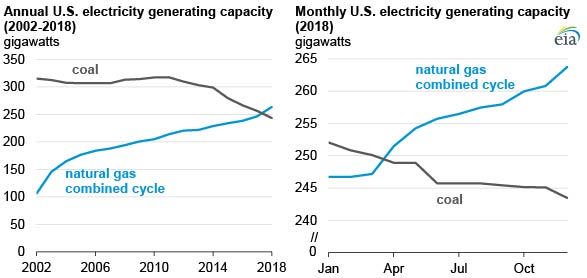The amount of generating capacity from natural gas-fired combined-cycle (NGCC) plants has grown steadily over time, and in 2018, surpassed coal-fired plants as the technology with the most electricity generating capacity in the United States. As of January 2019, U.S. generating capacity at NGCC power plants totaled 264 gigawatts (GW), compared with 243 GW at coal-fired power plants.

Total capacity for generating power in the United States across all types of natural gas-fired generating technologies surpassed coal as the primary capacity resource more than 15 years ago. However, different natural gas-fired generating technologies are used differently.
Steam turbines (which can also be powered by oil or coal) combust fuel to generate steam, which is used in a steam turbine to generate electricity. Combined-cycle units heat up fuel and use the fuel-air mixture to spin gas turbines and generate electricity. The waste heat from the gas turbine is used to generate steam for a steam turbine that generates additional electricity.
Natural gas-fired combustion and steam turbines are less efficient and more expensive to run, so they are typically used only during periods of peak electricity demand. Similarly, almost all coal plants (except integrated gasification units, which are rare) combust coal to generate steam, with little opportunity for efficiency improvements.

Follow us on social media: